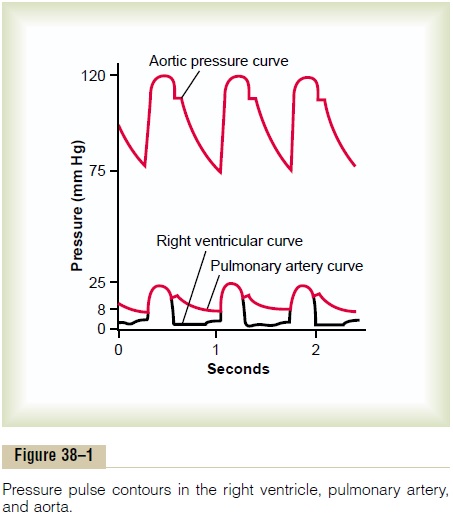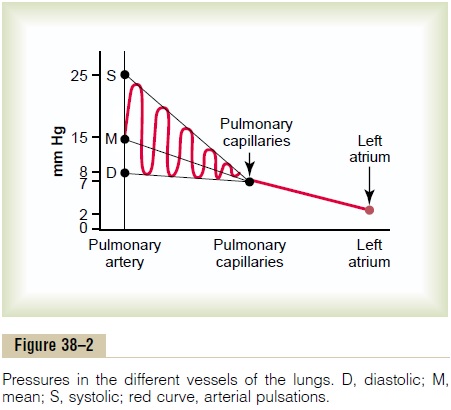Chapter: Medical Physiology: Pulmonary Circulation, Pulmonary Edema, Pleural Fluid
Pressures in the Pulmonary System
Pressures in the Pulmonary System
Pressure Pulse Curve in the Right Ventricle. The pressure pulse curves of the rightventricle and pulmonary artery are shown in the lower portion of Figure 38–1. These curves are contrasted with the much higher aortic pressure curve shown in the upper portion of the figure. The systolic pressure in the right ventricle of the normal human being averages about 25 mm Hg, and the diastolic pressure

Pressures in the Pulmonary Artery. Duringsystole,thepressure in the pulmonary artery is essentially equal to the pressure in the right ventricle, as also shown in Figure 38–1. However, after the pulmonary valve closes at the end of systole, the ventricular pressure falls precipitously, whereas the pulmonary arterial pressure falls more slowly as blood flows through the capillaries of the lungs.

As shown in Figure 38–2, the systolic pulmonaryarterial pressure averages about 25 mm Hg in the normal human being, the diastolic pulmonary arterialpressure is about 8 mm Hg, and the mean pulmonary arterial pressure is 15 mm Hg.
Pulmonary Capillary Pressure. The mean pulmonary cap-illary pressure, as diagrammed in Figure 38–2, is about 7 mm Hg. The importance of this low capillary pres-sure is discussed in detail later in relation to fluid exchange functions of the pulmonary capillaries.
Left Atrial and Pulmonary Venous Pressures. The meanpressure in the left atrium and the major pulmonary veins averages about 2 mm Hg in the recumbent human being, varying from as low as 1 mm Hg to as high as 5 mm Hg. It usually is not feasible to measure a human being’s left atrial pressure using a direct measuring device because it is difficult to pass a catheter through the heart chambers into the left atrium. However, the left atrial pressure can often be estimated with moderate accuracy by measuring the so-called pulmonary wedge pressure. This is achieved by inserting a catheter first through a peripheral vein to the right atrium, then through the right side of the heart and through the pulmonary artery into one of the small branches of the pulmonary artery, finally pushing the catheter until it wedges tightly in the smallbranch.
The pressure measured through the catheter, called the “wedge pressure,” is about 5 mm Hg. Because all blood flow has been stopped in the small wedged artery, and because the blood vessels extending beyond this artery make a direct connection with the pulmonary capillaries, this wedge pressure is usually only 2 to 3 mm Hg greater than the left atrial pressure. When the left atrial pressure rises to high values, the pulmonary wedge pressure also rises. Therefore, wedge pressure measurements can be used to clinically study changes in pulmonary capillary pressure and left atrial pressure in patients with congestive heart failure.
Related Topics